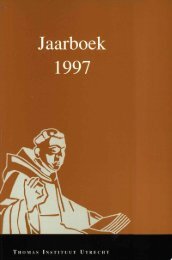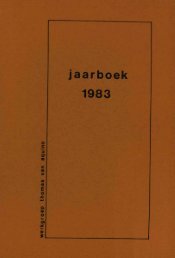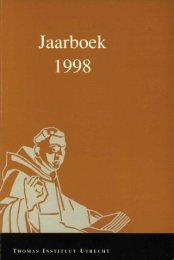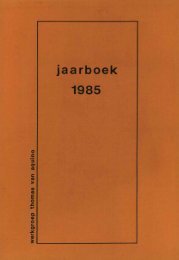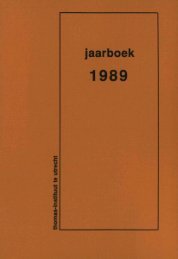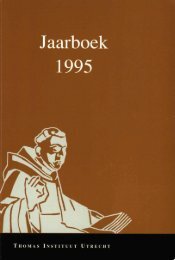Jaarboek Thomas Instituut 2006 - Thomas Instituut te Utrecht
Jaarboek Thomas Instituut 2006 - Thomas Instituut te Utrecht
Jaarboek Thomas Instituut 2006 - Thomas Instituut te Utrecht
You also want an ePaper? Increase the reach of your titles
YUMPU automatically turns print PDFs into web optimized ePapers that Google loves.
42 PIM VALKENBERG<br />
Living two centuries la<strong>te</strong>r than <strong>Thomas</strong> Aquinas, Nicholas of Cusa<br />
(1401-1464) was involved in at<strong>te</strong>mpts to reuni<strong>te</strong> the Wes<strong>te</strong>rn (Latin)<br />
and Eas<strong>te</strong>rn (Greek) churches as well. He wro<strong>te</strong> his book De docta<br />
ignorantia in 1440 just af<strong>te</strong>r the Council of Ferrara and Florence<br />
(1438-39). Although Nicholas probably did not at<strong>te</strong>nd the Council, he<br />
was sent as a delega<strong>te</strong> by the pope to Constantinople in order to<br />
facilita<strong>te</strong> its organization. The fall of Constantinople in 1453<br />
occasioned Nicholas to wri<strong>te</strong> his work on in<strong>te</strong>rfaith harmony, De<br />
pace fidei. In both cases, political events seemed to influence<br />
Cusanus' thinking on religious plurality as an advantage rather than<br />
as a hindrance to Christian truth."<br />
In the beginning of his book on learned ignorance Cusanus<br />
takes Anselm's well known formula id quo maius cogitari nequit<br />
("that than which nothing grea<strong>te</strong>r can be thought") as point of<br />
departure to charac<strong>te</strong>rize God as the Maximum that coincides with<br />
the Minimum since nothing is opposed to it.19 The three books of the<br />
docta ignorantia describe three ways of looking at this Maximum.<br />
First, the Maximum exists in itself in Oneness as the Absolu<strong>te</strong><br />
Maximum; in the second place, it exists in the universe as a<br />
contrac<strong>te</strong>d Maximum that does not exist independently of the<br />
plurality in which it is present; in the third place, it exists in Christ as<br />
the absolu<strong>te</strong> and contrac<strong>te</strong>d maximum at the same time. It is<br />
in<strong>te</strong>resting to no<strong>te</strong> that, according to Nicholas, all nations worship<br />
18 See Inigo Boeken, Nicholas of Cusa and the Plurality of Religions, in<br />
Barbara Roggema, Marcel Poorthuis, Pim Valkenberg (eds.), The Three<br />
Rings. Textual Studies in the Historical Trialogue of Judaism, Christianity,<br />
and Islam, Leuven 2005, 163-80.<br />
19 I used Jasper Hopkins' introduction to and translation of this work:<br />
Nicholas of Cusa on Learned Ignorance. A Translation and an Appraisal of<br />
Deo Docta Ignorantia, Minneapolis 1981. For the Latin <strong>te</strong>xt, I used Leo<br />
Gabriel (Hrsg.), Nikolaus von Kues, Philosophisch-theologische Schrif<strong>te</strong>n,<br />
übersetzt und kommentiert von Oietlind und Wilhelm Dupré, Wien 1964,<br />
Band I, 192-297, and also Paul Wilpert's edition in two volumes: Nikolaus<br />
von Kues Werke, Berlin 1967. Other English translations may be found in: Of<br />
Learned Ignorance by Nicolas Cusanus, transla<strong>te</strong>d by Fr. Germain Heron,<br />
with an introduction by Dr. D. Hawkins, New Haven CT 1954, and Nicholas<br />
of Cusa: selec<strong>te</strong>d spiritual writings, transla<strong>te</strong>d and introduced by H.<br />
Lawrence Bond, New YorklMahwah N.J. 1997, 87-206. Cusanus, docta<br />
ignorantia 1.2, tr. Hopkins p. 51.



